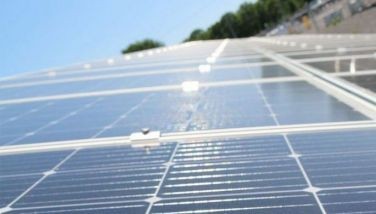BBB talks

It’s Build Build Build for the Philippines; it’s Build Back Better for the United States. The former is on P8.4-trillion plan, hatched during the first year of President Duterte’s term, to usher in the country’s golden age of infrastructure. The latter is a $4-trillion spending plan, also for infrastructure, declared by President Joe Biden as “a transformative effort to overhaul the country’s economy.”
Duterte’s BBB is due for a report card as his administration goes into its last months to give way to the next government. Biden’s legislative plan, announced early this year, is separated in three parts: the first two have cleared US Congress, and the third is still going through the legislative mill.
Both, based on the proposed spending scales, are landmark in their own rights. Both countries have not been spending enough on infrastructure to fuel aspirational economic growth, and is badly need for the medium to long term.
Let’s get on with tackling how the Philippines has managed during the last five years.
Significantly higher spending
The Philippines’ BBB program has successfully paved the way for ramped-up infrastructure spending. Whether Duterte’s men can claim credit to all projects completed and ongoing to be their doing alone, the fact remains that infrastructure spending is now more than double what past administrations have allocated as a percentage of the country’s gross domestic product (GDP).
Public infrastructure outlays were 6.3 percent and 6.2 percent of GDP before the pandemic struck, but while uptake had been much lower, it represented a strong commitment by the government to address the backlog in needed new roads, bridges, ports, mass transportation systems, and other building projects linked to social services.
Less than half of the original 75 “big” infrastructure projects have been removed from the list, and replaced with more but smaller doable projects. A number of big projects initiated by the private sector under the state-led Public-Private Partnership program had also somehow made its way to the current list, thus fudging the yawning gap in spending.
A number of problems, including right-of-way (ROW) challenges, had caused the slow start of the BBB rollout in the first two years of the Duterte era, and just as things were starting to roil in the third year, the pandemic put a stop to many construction works.
Completed and new projects
Nevertheless, Duterte’s term ends with quite a number of completed projects, just don’t ask when (or under whose presidency) the projects started. More importantly, though, many notable projects had started during the current administration, even if almost all of them will be completed beyond Duterte’s term.
Some of the exciting new projects worth closely monitoring, together with their expected completion, are the Metro Manila Subway (phase 1 by 2027), the PNR North-South Commuter railway (2025), MRT Line 7 (December 2022), and the new Manila or Bulacan international airport (2026).
The updated list of Duterte’s BBB boasts of a number of new projects funded through official development assistance (ODA) that carry a lower interest rate spread over longer periods. These particularly result in greater leverage for economic growth of future generations.
Overall, targets set in 2016 were not met, but such big ambitions facilitated an infrastructure building boom not seen for quite some time now. It may not live up to the promise of being the country’s golden age of infrastructure goal, but the results are still commendable.
Fixing infrastructure
The US is undertaking one of its biggest infrastructure resets, definitely gargantuan compared to our BBB. Since the 1950s, national government spending on public infrastructure in American had been slowing down, and as a result, has left many facilities in need of upgrades and repairs.
What is happening is so un-first world, something that taints the touted leadership image of the world’s biggest economy. No wonder many ask if the US economy is on a decline. Juxtaposed against China’s vibrant economic landscape, America seems to be decaying.
Biden, however, is bent on fixing this. The plans call for more roads and bridges, transport modernization, a notable support for electric vehicle use, plus some money for upgrading its rail systems. Funds are also being set aside for broadband development.
The amount set aside for Biden’s infrastructure building plan is $1.2 trillion, which many critics feel is not enough to mend what is currently broken or needs fixing, but would still go a long way towards rehabilitating what is currently on the ground or even introducing necessary modernization.
Like the Philippines, the US is also relying on the private sector to augment public infrastructure investments. A number of clauses in the third part of Biden’s BBB is expected to encourage this.
Risks and audacity
Spending on infrastructure by governments to propel economic growth is by no means regarded as Bible truth. Critics pounce at the audacity of pouring huge amounts of tax money, often most of which are borrowed, to be paid by future generations.
Modern history has taught us that risks abound, even with the best laid out economic plans. However, for those counties that successfully managed to pull through without being paralyzed by debt payment defaults, the gains had been worth the risks.
The Philippines, and even the US, will be sharing a similar stage in the coming years as both try to maximize gains from infrastructure investments while keeping a tight watch on fiscal discipline, including attempting new or higher taxes to pay for the huge investments in infrastructure.
Facebook and Twitter
We are actively using two social networking websites to reach out more often and even interact with and engage our readers, friends and colleagues in the various areas of interest that I tackle in my column. Please like us on www.facebook.com/ReyGamboa and follow us on www.twitter.com/ReyGamboa.
Should you wish to share any insights, write me at Link Edge, 25th Floor, 139 Corporate Center, Valero Street, Salcedo Village, 1227 Makati City. Or e-mail me at [email protected]. For a compilation of previous articles, visit www.BizlinksPhilippines.net.
- Latest
- Trending




























